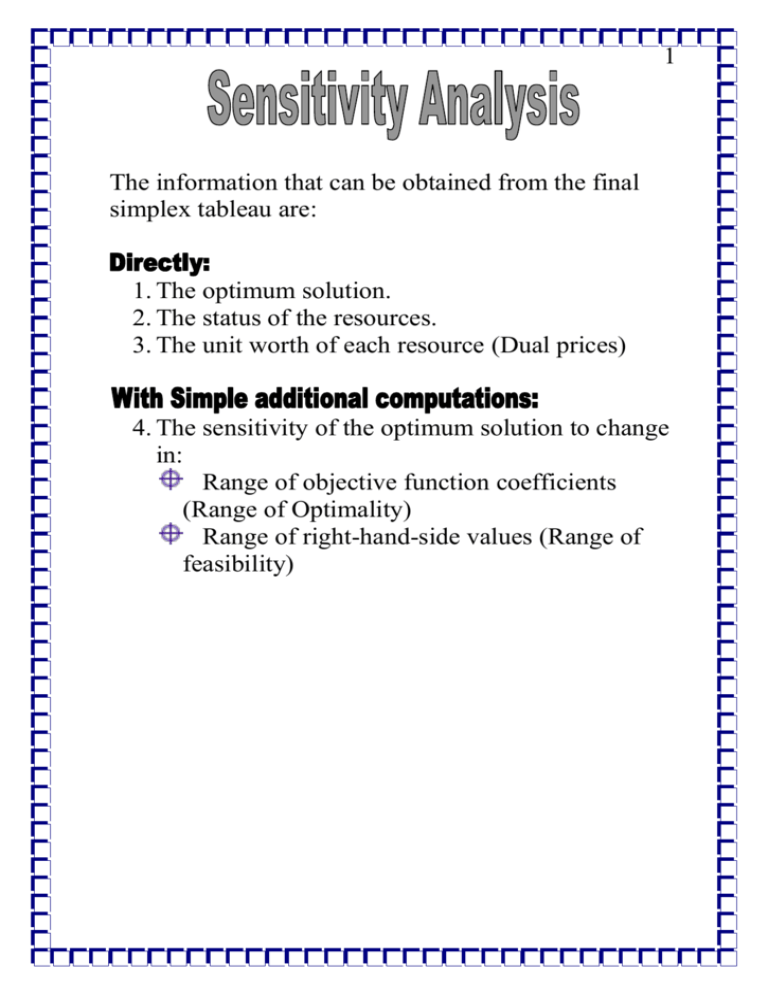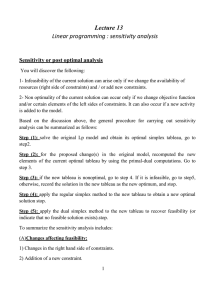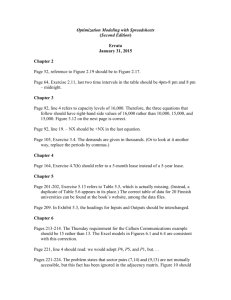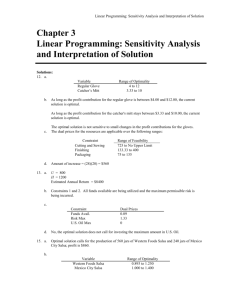File
advertisement

1 The information that can be obtained from the final simplex tableau are: 1. The optimum solution. 2. The status of the resources. 3. The unit worth of each resource (Dual prices) 4. The sensitivity of the optimum solution to change in: Range of objective function coefficients (Range of Optimality) Range of right-hand-side values (Range of feasibility) 2 Example 50 x1 40 x2 Max s.t. 3x1 5x2 150 Assembly time 1x2 20 Portable display 8 x1 5 x2 300 Warehouse capacity x1 , x2 0 where x1 = number of units of the Deskpro x 2 = number of units of the Portable The final simplex tableau for the problem is: x1 x2 s1 s2 s3 0 0 0 1 3 25 0 3 25 0 5 Basis cB 50 40 x2 s2 x1 40 0 1 8 0 0 0 8 50 1 0 5 zj 50 40 14 cj zj 0 0 25 5 14 5 x1 =30, x 2 =12, and Z=1980 0 0 25 25 25 26 5 26 5 12 8 30 1980 3 Resource Slack Variable 1. Assembly time S1=0 2. Portable display S2=8 3. Warehouse capacity S3=0 Status of Resource Scarce (binding) Abundant (non-binding) Scarce(binding) The range of optimality for an objective function coefficient for any basic variable is determined by cj zj 0 for all values of j. For Example: The range of optimality for c1 x1 x2 s1 s2 s3 0 0 0 25 1 3 25 0 3 25 64 c1 5 0 5 Basis cB c1 40 x2 s2 x1 40 0 1 8 0 0 0 8 c1 1 0 5 zj c1 40 cj zj 0 0 c1 64 5 0 25 c1 64 0 24 c1 5 24 c1 0 24 c1 64 12 8 30 25 c1 24 480+30 c1 5 24 c1 0 5 c1 64 0 5 c1 64 0 25 c1 24 4 Hints : c 1. If there are two or more upper bounds on k , the smallest of these is the upper bound on the range of optimality. c 2. If there are two or more lower bounds on k , the largest of these is the lower bound on the range of optimality. 3. The range of optimality for the objective function coefficient of any nonbasic variable is given by Problems 1. Suppose an increase in material costs reduces the profit per unit for the Deskpro to $30, what is the optimal solution? 2. Suppose an increase in material costs reduces the profit per unit for the Deskpro to $15, what is the optimal solution? Steps to compute the range of optimality for objective function. (See Textbook page 50 (82) 5 The right-hand-side values (the bi s) are the resource available. Dual Prices (Shadow prices) provide information on the value of additional resources. Dual price is the improvement in value of the optimal solution per-unit increase in a constraint's right-handside value. The zj values for the slack variables in the final simplex tableau are the dual prices x1 x2 s1 s2 s3 0 0 0 1 3 25 0 3 25 0 5 Basis cB 50 40 x2 s2 x1 40 0 1 8 0 0 0 8 50 1 0 5 25 25 12 25 8 25 30 26 0 5 5 1980 cj zj 0 0 14 5 0 26 5 The dual prices for the assembly time constraint, Portable display constraint, and warehouse capacity constraint are respectively 14 = $2.8, 0.0, and 26 =$5.2. 5 5 More warehouse space will have the biggest positive impact on profit. zj 50 40 14 6 Table 1 summarizes the rules for determining the dual prices for the various constraint types. Constraint Type Dual Price Given by zj value for the slack variable associated ≤ with the constraint Negative of the zj value for the surplus ≥ variable associated with the constraint zj value for the artificial variable = associated with the constraint Dual prices for a minimization problem Table 2 DUAL PRICES 7 The range of values over which a particular bi can vary without any of the current basic variables becoming infeasible (i.e., less than zero) will be referred to as the range of feasibility. Calculate the range of values for bi that satisfy the following inequalities. Current solution Column of the final simplex (last column of tableau correspond ing to the bi the final simplex slack vari able associated tableau) with constraint i 0 0 . 0 The range of feasibility can be established by the maximum of the lower limits and the minimum of the upper limits. 8 Example The final simplex tableau for the problem is: x1 x2 s1 s2 s3 0 0 0 1 3 25 0 3 25 0 5 Basis cB 50 40 x2 s2 x1 40 0 1 8 0 0 0 8 50 1 0 5 zj 50 40 14 cj zj 0 0 25 5 14 5 0 0 25 25 25 26 5 26 5 12 8 30 1980 To compute upper and lower bounds for the maximum amount that b1 can be changed before the current optimal basis becomes infeasible. 8 0 12 25 8 b 8 0 1 25 5 0 30 25 12 8 b 0 25 1 b1 37.5 8 8 b 0 30 5 b1 0 25 1 25 b1 25 b1 150 37.5 b1 25 150 37.5 150 b1 150 25 112.5 b1 175 The range of feasibility for b1 indicates that as long as the available assembly time is between 112.5 and 175 hours, the current optimal basis will remain feasible. 9 Problems 1. Suppose that we increase b1 by 5, what is the optimal solution? 2. Suppose that we increase b1 by 25, what is the optimal solution? (See textbook page 56) 3. Suppose that we increase b1 by 40, what is the optimal solution? 1. Because the dual price for b1 (assembly time) is 14 5 , we know profit can be increased by $2.80 by obtaining an additional hour of assembly time. The profit = $1980+($2.8)5=$1994 The values of the optimal basic variables 25 13.6 s 8 5 8 6.4 25 x 30 5 5 29 25 x2 12 5 8 2 1 To determine the range of feasibility for the right-hand-side value of ≥ constraint See textbook page 57 Changes that force bi outside its range of feasibility will force us to resolve the problem to find the new optimal solution consisting of a different set of basic variables. (More advanced linear programming texts show how it can be done without completely resolving the problem.)











